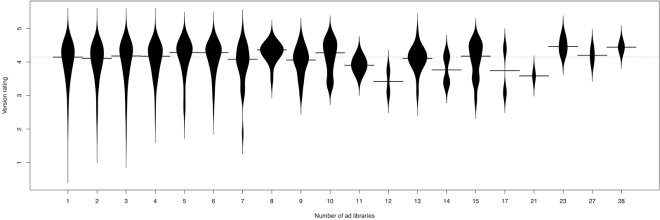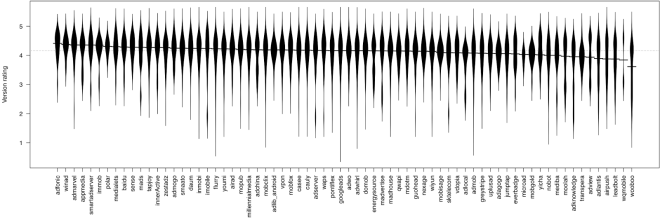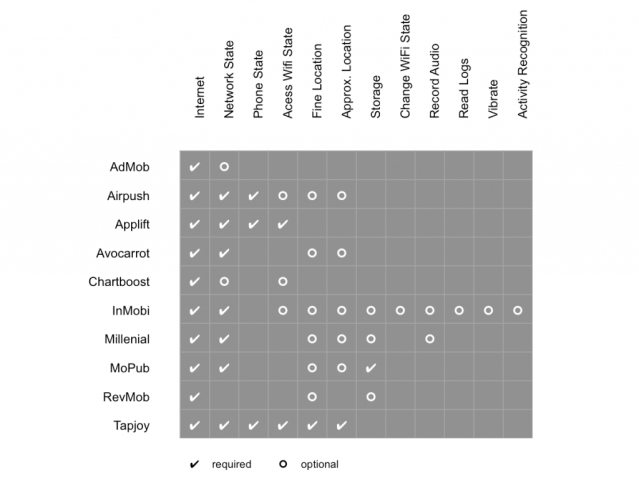In our case study we started with a set of 236,245 free to download Android apps from the Google Play store mined in 2011. Overall we found that the apps connected to 72 different ad networks through the respective libraries. In all there were three key findings in our study:

Finding 1: Developers integrated more than one ad library quite frequently.

We find that most apps have only one ad library in them. However, at least 42,206 of the apps with ad libraries in them have two or more ad libraries. Fig. 1 shows a breakdown of the number of apps based on the number of ad libraries integrated in the apps. We even find eight apps with as much as 28 ad libraries!!
Finding 2: We found no evidence of a relationship between the number of ad libraries and the user rating of an app.

In Fig. 2 we break down the data and show more details by means of a bean plot of the rating of apps grouped by the number of integrated ad libraries. Bean plots show both the median value for the rating (indicated by the solid horizontal line), and the actual distribution (the width of the curve at any point in each bean plot indicates the number of apps with a particular rating). Since app ratings can be biased by a few raters, in the above Figure and the rest of the study, we filtered out apps with less than 10 raters and fewer than 2 releases in an entire year (unmaintained apps), which resulted in a set of 13,983 versions distributed across 5,937 different apps.
The Spearman rank correlation (correlation among the relative ranks rather than the actual values) between the number of ad libraries integrated in an app and the rating of the app is 0.016. Such a weak correlation illustrates that there is no relationship between the number of ad libraries in an app and the rating of the app.
Finding 3: Apps that integrated certain specific ad libraries had a noticeably lower ratings.

We observe that ad libraries with a highly intrusive behaviour result in complaints from app users, and in some occasions ruin the users’ perceived quality of the app. We find comments such as: “Good game, bad ads. I was loving the game until I noticed it put a new shortcut called ‘Apps’ on my launcher. Sorry, but if your idea of advertising is putting sh*t in launcher pages or notifications then I’m not interested. Keep ads INSIDE the app.”. At the time of our study, apps that included Wooboo, Leadbolt and Airpush all had lower ratings. We found that these ad libraries had an intrusive behaviour (as explained in more detail in our paper). Recently, Google Play updated its policies to encourage the app developers to be more conscious with ad libraries that have highly intrusive behaviour. They also updated their ad policy in mobile apps which has forced ad libraries to either change or risk not being included.
Recommendation
Given a certain real estate space that the ads will occupy on the screen of a device (control variable), app developers can add as many ad libraries as needed to increase the fill rate (ratio of number of ads received to the number of ads requested) without impacting their ratings. However, developers need to be careful and selective about the specific ad libraries that they integrate.
You can find more details about the case study in our paper published in the Nov-Dec 2014 issue of IEEE Software. (Preprint)







